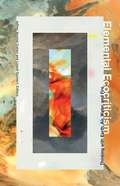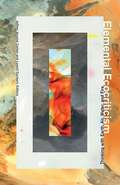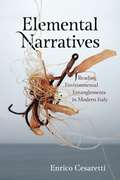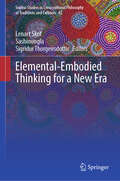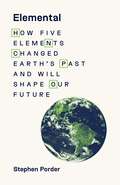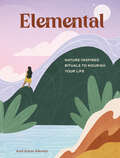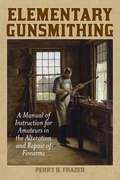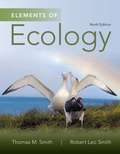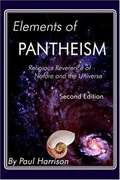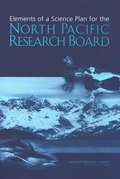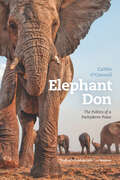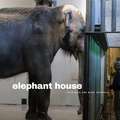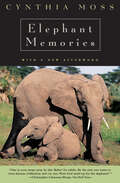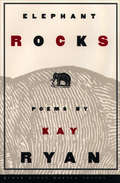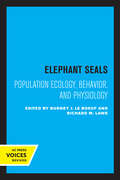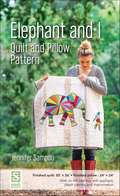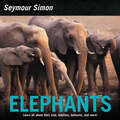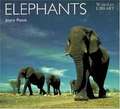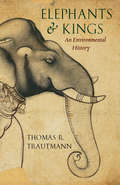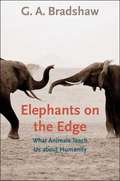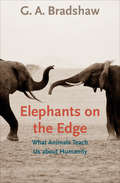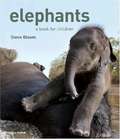- Table View
- List View
Elemental Ecocriticism: Thinking with Earth, Air, Water, and Fire
by Jeffrey Jerome Cohen Lowell DuckertFor centuries it was believed that all matter was composed of four elements: earth, air, water, and fire in promiscuous combination, bound by love and pulled apart by strife. Elemental theory offered a mode of understanding materiality that did not center the cosmos around the human. Outgrown as a science, the elements are now what we build our houses against. Their renunciation has fostered only estrangement from the material world. The essays collected in Elemental Ecocriticism show how elemental materiality precipitates new engagements with the ecological. Here the classical elements reveal the vitality of supposedly inert substances (mud, water, earth, air), chemical processes (fire), and natural phenomena, as well as the promise in the abandoned and the unreal (ether, phlogiston, spontaneous generation). Decentering the human, this volume provides important correctives to the idea of the material world as mere resource. Three response essays meditate on the connections of this collaborative project to the framing of modern-day ecological concerns. A renewed intimacy with the elemental holds the potential of a more dynamic environmental ethics and the possibility of a reinvigorated materialism.
Elemental Ecocriticism: Thinking with Earth, Air, Water, and Fire
by Jeffrey Jerome Cohen Lowell DuckertFor centuries it was believed that all matter was composed of four elements: earth, air, water, and fire in promiscuous combination, bound by love and pulled apart by strife. Elemental theory offered a mode of understanding materiality that did not center the cosmos around the human. Outgrown as a science, the elements are now what we build our houses against. Their renunciation has fostered only estrangement from the material world.The essays collected in Elemental Ecocriticism show how elemental materiality precipitates new engagements with the ecological. Here the classical elements reveal the vitality of supposedly inert substances (mud, water, earth, air), chemical processes (fire), and natural phenomena, as well as the promise in the abandoned and the unreal (ether, phlogiston, spontaneous generation).Decentering the human, this volume provides important correctives to the idea of the material world as mere resource. Three response essays meditate on the connections of this collaborative project to the framing of modern-day ecological concerns. A renewed intimacy with the elemental holds the potential of a more dynamic environmental ethics and the possibility of a reinvigorated materialism.
Elemental Narratives: Reading Environmental Entanglements in Modern Italy (AnthropoScene)
by Enrico CesarettiOver the past century, the Italian landscape has undergone exceedingly rapid transformations, shifting from a mostly rural environment to a decidedly modern world. This changing landscape is endowed with a narrative agency that transforms how we understand our surroundings. Situated at the juncture of Italian studies and ecocriticism and following the recent “material turn” in the environmental humanities, Elemental Narratives outlines an original cultural and environmental map of the bel paese. Giving equal weight to readings of fiction, nonfiction, works of visual art, and physical sites, Enrico Cesaretti investigates the interconnected stories emerging from both human creativity and the expressive eloquence of “glocal” materials, such as sulfur, petroleum, marble, steel, and asbestos, that have helped make and, simultaneously, “un-make” today’s Italy, affecting its socio-environmental health in multiple ways. Embracing the idea of a decentralized agency that is shared among human and nonhuman entities, Cesaretti suggests that engaging with these entangled discursive and material texts is a sound and revealing ecocritical practice that promises to generate new knowledge and more participatory, affective responses to environmental issues, both in Italy and elsewhere. Ultimately, he argues that complementing quantitative, data-based information with insights from fiction and nonfiction, the arts, and other humanistic disciplines is both desirable and crucial if we want to modify perceptions and attitudes, increase our awareness and understanding, and, in turn, develop more sustainable worldviews in the era of the Anthropocene. Elegantly written and convincingly argued, this book will appeal broadly to scholars and students working in the fields of environmental studies, comparative literatures, ecocriticism, environmental history, and Italian studies.
Elemental Narratives: Reading Environmental Entanglements in Modern Italy (AnthropoScene: The SLSA Book Series #6)
by Enrico CesarettiOver the past century, the Italian landscape has undergone exceedingly rapid transformations, shifting from a mostly rural environment to a decidedly modern world. This changing landscape is endowed with a narrative agency that transforms how we understand our surroundings. Situated at the juncture of Italian studies and ecocriticism and following the recent "material turn" in the environmental humanities, Elemental Narratives outlines an original cultural and environmental map of the bel paese. Giving equal weight to readings of fiction, nonfiction, works of visual art, and physical sites, Enrico Cesaretti investigates the interconnected stories emerging from both human creativity and the expressive eloquence of "glocal" materials, such as sulfur, petroleum, marble, steel, and asbestos, that have helped make and, simultaneously, "un-make" today’s Italy, affecting its socio-environmental health in multiple ways. Embracing the idea of a decentralized agency that is shared among human and nonhuman entities, Cesaretti suggests that engaging with these entangled discursive and material texts is a sound and revealing ecocritical practice that promises to generate new knowledge and more participatory, affective responses to environmental issues, both in Italy and elsewhere. Ultimately, he argues that complementing quantitative, data-based information with insights from fiction and nonfiction, the arts, and other humanistic disciplines is both desirable and crucial if we want to modify perceptions and attitudes, increase our awareness and understanding, and, in turn, develop more sustainable worldviews in the era of the Anthropocene. Elegantly written and convincingly argued, this book will appeal broadly to scholars and students working in the fields of environmental studies, comparative literatures, ecocriticism, environmental history, and Italian studies.
Elemental-Embodied Thinking for a New Era (Sophia Studies in Cross-cultural Philosophy of Traditions and Cultures #42)
by Lenart Škof Sigridur Thorgeirsdottir SashinunglaThis collection responds to widespread, complex, and current environmental challenges by presenting eleven original essays on a new elemental-embodied approach in environmental humanities. This approach has a special focus on elemental and indigenous philosophies as well as localized experiences of terrestrial forces: from earthquakes and eruptions to pandemics and natural disasters. Representing a shift in modern Western scientific and disembodied thinking of nature, this edited book approaches the question of relationality and intertwining of human and natural being by utilizing the elemental-embodied methodologies within philosophy of embodiment and nature. Supported by research in cognitive sciences, the contributors represent the experiential and affective turn within research into human cognition. As embodied, the human being is embedded and interacting with all there is. The aim of this edited volume is to indicate new paths toward regaining our access to natural being within usand thus toward reconnecting with the natural environment and the things and beings around us in a new, environmentally enhanced way. It appeals to researchers and students working in many fields, predominantly in philosophy, as well as religious and environmental studies.
Elemental: How Five Elements Changed Earth’s Past and Will Shape Our Future
by Stephen PorderAn ecologist explores how life itself shapes Earth using the elemental constituents we all shareIt is rare for life to change Earth, yet three organisms have profoundly transformed our planet over the long course of its history. Elemental reveals how microbes, plants, and people used the fundamental building blocks of life to alter the climate, and with it, the trajectory of life on Earth in the past, present, and future.Taking readers from the deep geologic past to our current era of human dominance, Stephen Porder focuses on five of life&’s essential elements—hydrogen, oxygen, carbon, nitrogen, and phosphorus. He describes how single-celled cyanobacteria and plants harnessed them to wildly proliferate across the oceans and the land, only to eventually precipitate environmental catastrophes. He then brings us to the present, and shows how these elements underpin the success of human civilization, and how their mismanagement threatens similarly catastrophic unintended consequences. But, Porder argues, if we can learn from our world-changing predecessors, we can construct a more sustainable future.Blending conversational storytelling with the latest science, Porder takes us deep into the Amazon, across fresh lava flows in Hawaii, and to the cornfields of the American Midwest to illuminate a potential path to sustainability, informed by the constraints imposed by life&’s essential elements and the four-billion-year history of life on Earth.
Elemental: The Path to Healing Through Nature
by Andi Eaton AllemanAncient humans had an intimate connection to nature—we lived by the cycles of the sun and the moon, followed the flow of water when determining where to settle, and planted and sowed according to the shifts in seasons. With beautiful rituals and simple activities that return us to nature, Elemental teaches us to disconnect from the digital world to find better health and inner peace.The five elements—fire, earth, water, air, and ether—reside in each of us. In this richly illustrated book, Andi Eaton explores the energy each element holds, and teaches you how to incorporate a balance of each into your daily wellness practices: • Glow-inducing meditation and breathwork: Use a Breath of Fire exercise to glow with fire's energy• Rituals for grounding and balance: Host a Moon Manifestation Circle to ground yourself with earth's energy• Nourishing recipes and exercises: Take a Goddess Bath to nourish yourself with water's energyAs you explore each of the elements, you'll learn how to let your body speak and become an active listener to what it has to say. Elemental is about reconnecting with yourself: what lights you up and what leaves you feeling physically, emotionally, and spiritually balanced.
Elementary Gunsmithing: A Manual of Instruction for Amateurs in the Alteration and Repair of Firearms
by Perry D. FrazerA beginner’s guide to the ins and outs of guncraftsmanship from a professional gunsmith.When it was first published in 1938, Elementary Gunsmithing was one of the few books of the time to address an amateur audience, among more advanced titles. With clear, engaging, and instructional prose, Frazer takes beginner firearm interest to the next level by talking the reader through the fundamentals of gunsmithing, such as what tools are necessary for the craft, how to solder and mount parts, and even how to conduct a fledgling gunsmithing business. He specifically addresses the "young man who likes working at the bench,” and similarly the book reflects the spirit of innovation, resourcefulness, and do-it-yourself work.While the book may not cover contemporary firearms, it offers a grandfatherly, old-school instructional vibe with accurate information about guns up to the 1940s. Frazer focuses on gunsmithing with ordinary hand tools at the work bench, rather than complicated machinery. These helpful tips and information, which are still applicable today, make Elementary Gunsmithing a useful, classic, and historically significant reference for both amateurs and budding gunsmithers keen on building a full-time business.Skyhorse Publishing is proud to publish a broad range of books for hunters and firearms enthusiasts. We publish books about shotguns, rifles, handguns, target shooting, gun collecting, self-defense, archery, ammunition, knives, gunsmithing, gun repair, and wilderness survival. We publish books on deer hunting, big game hunting, small game hunting, wing shooting, turkey hunting, deer stands, duck blinds, bowhunting, wing shooting, hunting dogs, and more. While not every title we publish becomes a New York Times bestseller or a national bestseller, we are committed to publishing books on subjects that are sometimes overlooked by other publishers and to authors whose work might not otherwise find a home.
Elements Of Ecology (Ninth Edition)
by Robert Leo Smith Thomas M. SmithElements of Ecology, Ninth Edition continues to explain ecological processes clearly and concisely, with a greater emphasis on the relevance of ecology to everyday life and the human impact on ecosystems. This dramatically revised edition discusses issues of human ecology throughout the text and provides a greater variety of opportunities for students to learn, practice, and develop quantitative and analytical skills.
Elements of Environmental Management
by Werner AntweilerAs businesses face an increasing array of environmental challenges, including climate change, air and water pollution, and solid waste management, environmental management has become an increasingly important area of expertise. Elements of Environmental Management is an interdisciplinary textbook for students and business professionals that integrates corporate environmental strategy with environmental economics, environmental law, and environmental engineering.Written by Werner Antweiler, an expert on international trade and environmental economics, Elements of Environmental Management approaches environmental issues from a business perspective: How can businesses respond to public policies and regulatory requirements? How does emission trading work? What technological options are available to prevent or mitigate pollution? Using examples from a wide range of industries, Antweiler presents the essential tools for examining environmental problems from a business perspective.
Elements of Pantheism (2nd edition)
by Paul A. HarrisonThis accessible, clear and authoritative handbook is the only available introduction to the history, theory and practice of Pantheism. One of the most extraordinary books written in recent years about the subject of religion.
Elements of a Science Plan for the North Pacific Research Board
by Committee on a Science Plan for the North Pacific Research BoardThe North Pacific Research Board (NPRB) was established in 1997 as custodian to a pool of funds intended for the study of the North Pacific Ocean, Bering Sea, and Arctic Ocean. The success of the NRPB is the development of a high quality, long-range science plan that provides a better understanding of ecosystems and their fisheries in the region. This report provides a framework to help the NPRB identify appropriate science themes and mechanisms for administering and distributing the funds. It contains extensive input from residents of Alaskan communities, to help scientists understand and address issues of importance to the local communities. The book makes specific recommendations on long-term research priorities, the NPRB management structure and the development of future programs.
Elephant Don: The Politics of a Pachyderm Posse
by Caitlin O'ConnellMeet Greg. He's a stocky guy with an outsized swagger. He's been the intimidating yet sociable don of his posse of friends--including Abe, Keith, Mike, Kevin, Torn Trunk, and Willie. But one arid summer the tide begins to shift and the third-ranking Kevin starts to get ambitious, seeking a higher position within this social club. But this is no ordinary tale of gangland betrayal--Greg and his entourage are bull elephants in Etosha National Park, Namibia, where, for the last twenty-three years, Caitlin O'Connell has been a keen observer of their complicated friendships. In Elephant Don, O'Connell, one of the leading experts on elephant communication and social behavior, offers a rare inside look at the social world of African male elephants. Elephant Don tracks Greg and his group of bulls as O'Connell tries to understand the vicissitudes of male friendship, power struggles, and play. A frequently heart-wrenching portrayal of commitment, loyalty, and affection between individuals yearning for companionship, it vividly captures an incredible repertoire of elephant behavior and communication. Greg, O'Connell shows, is sometimes a tyrant and other times a benevolent dictator as he attempts to hold onto his position at the top. Though Elephant Don is Greg's story, it is also the story of O'Connell and the challenges and triumphs of field research in environs more hospitable to lions and snakes than scientists. Readers will be drawn into dramatic tales of an elephant society at once exotic and surprisingly familiar, as O'Connell's decades of close research reveal extraordinary discoveries about a male society not wholly unlike our own. Surely we've all known a Greg or two, and through this book we may come to know them in a whole new light.
Elephant House (Animalibus)
by Nigel RothfelsIn Elephant House, photographer Dick Blau and historian Nigel Rothfels offer a thought-provoking study of the Oregon Zoo’s Asian Elephant Building and the daily routines of its residents—human and pachyderm alike. Without an agenda beyond a desire to build a deeper understanding of this enigmatic environment, Elephant House is the result of the authors’ unique creative collaboration and explores the relationships between captive elephants and their human caregivers.Blau’s evocative photographs are complex and challenging, while Rothfels’s text offers a scholarly and personal response to the questions that surround elephants and captivity. Elephant House does not take sides in the debate over zoos but focuses instead on the bonds of attentiveness between the animals and their keepers. Accompanied by a foreword from retired elephant keeper Mike Keele, Elephant House is a frank, fascinating look at the evolving world of elephant husbandry.
Elephant House (Animalibus: Of Animals and Cultures #7)
by Dick Blau Nigel RothfelsIn Elephant House, photographer Dick Blau and historian Nigel Rothfels offer a thought-provoking study of the Oregon Zoo’s Asian Elephant Building and the daily routines of its residents—human and pachyderm alike. Without an agenda beyond a desire to build a deeper understanding of this enigmatic environment, Elephant House is the result of the authors’ unique creative collaboration and explores the relationships between captive elephants and their human caregivers.Blau’s evocative photographs are complex and challenging, while Rothfels’s text offers a scholarly and personal response to the questions that surround elephants and captivity. Elephant House does not take sides in the debate over zoos but focuses instead on the bonds of attentiveness between the animals and their keepers. Accompanied by a foreword from retired elephant keeper Mike Keele, Elephant House is a frank, fascinating look at the evolving world of elephant husbandry.
Elephant Memories: Thirteen Years in the Life of an Elephant Family
by Cynthia Moss&“A style so conversational…that I felt like a privileged visitor riding beside her in her rickety Land-Rover as she showed me around the park." —The New York Times Book Review Cynthia Moss spent many years living in Kenya&’s Amboseli National Park and studying the elephants there, and her long-term research has revealed much of what we now know about these complex and intelligent animals. In this book, she shares a more up-close and personal perspective, chronicling the lives of the elephant families led by matriarchs Teresia, Slit Ear, Torn Ear, Tania, and Tuskless, including a rare look at calves and their development. This edition is also updated with a new afterword, catching up on the families, covering current conservation issues, and &“celebrating a species from which we could learn some moral as well as zoological lessons&” (Chicago Tribune). &“One is soon swept away by this &‘Babar&’ for adults. By the end, one even begins to feel an aversion for people. One wants to curse human civilization and cry out, &‘Now God stand up for the elephants!&’&”—The New York Times &“Moss speaks to the general reader, with charm as well as scientific authority…[An] elegantly written and ingeniously structured account.&”—TheWall Street Journal &“Any reader interested in animals will be captivated.&”—Publishers Weekly
Elephant Rocks: Poems (Books That Changed the World)
by Kay RyanThe former US Poet Laureate shares &“fine poems that inspire us with poetry&’s greatest gifts: the music of language and the force of wisdom&” (Annie Dillard, Pulitzer Prize–winning author). Elephant Rocks, Kay Ryan&’s third book of verse, shows a virtuoso practitioner at the top of her form. Engaging and secretive, provocative and profound, Ryan&’s poems have generated growing excitement with their appearances in The New Yorker and other leading periodicals. Sometimes gaudily ornamental, sometimes Shaker-plain, here is verse that is compact on the page and expansive in the mind. &“Kay Ryan makes it all fresh again with her highly original vision, her elegant, quirky craft. These poems look easy, but the deeper one delves, the more they astonish and astound.&” —May Sarton, New York Times–bestselling author of At Eighty-Two &“Kay Ryan works toward an exciting art, much less sparse than it looks. This is natural history seen from an angle of vision that Emerson and Dickinson would have approved. It refreshes me to find poems that require and reward rereading as much as these do.&” —Harold Bloom, literary critic and author of The Bright Book of Life &“The music of these poems is every bit as seductive as their reasoning. Her thinking flaunts the plush, irresistible textures of organic growth . . . Marvelous.&” —Boston Review &“These poems show a poet who is terribly sly in her reckoning of our world.&” —David St. John, author of The Last Troubadour: New and Selected Poems &“So original, so astute, so pleasurable are the poems in this book, it wouldn&’t be at all surprising if they&’re still being read long after current critical fashions are dated.&” —Poetry
Elephant Seals: Population Ecology, Behavior, and Physiology
by Burney J. Le Boeuf Richard M. LawsThe largest of all seals, elephant seals rank among the most impressive of marine mammals. They are renowned for their spectacular recovery from near-extinction at the end of the nineteenth century when seal hunters nearly eliminated the entire northern species. No other vertebrate has come so close to extinction and made such a complete recovery. The physiological extremes that elephant seals can tolerate are also remarkable: females fast for a month while lactating, and the largest breeding males fast for over one hundred days during the breeding seasons, at which times both sexes lose forty percent of their body weight. Elephant seals dive constantly during their long foraging migrations, spending more time under water than most whales and diving deeper and longer than any other marine mammal. This first book-length discussion of elephant seals brings together worldwide expertise from scientists who describe and debate recent research, including the history and status of various populations, their life-history tactics, and other findings obtained with the help of modern microcomputer diving instruments attached to free-ranging seals. Essential for all marine mammalogists for its information and its methodological innovations, Elephant Seals will also illuminate current debates about species extinctions and possible means of preventing them. This title is part of UC Press's Voices Revived program, which commemorates University of California Press’s mission to seek out and cultivate the brightest minds and give them voice, reach, and impact. Drawing on a backlist dating to 1893, Voices Revived makes high-quality, peer-reviewed scholarship accessible once again using print-on-demand technology. This title was originally published in 1994.
Elephant and I Quilt and Pillow Pattern
by Jennifer SampouStitch a scrap-friendly quilt and pillow inspired by Jennifer Sampou’s travels to Thailand. The best-selling fabric designer pairs paper-pieced and appliquéd motifs with a background of easy-to-sew strips. Gender-neutral and customizable, this artistically modern design is a definite showpiece. The full-size pattern includes complete instructions to make a quilt and a matching pillow. Proceeds from the sale of this pattern will be donated to Elephant Nature Park in Thailand, whose mission is to provide a rescue and rehabilitation center for elephants. Unique, gender-neutral design with full-size patterns Soft background with a splash of vibrant color Paper-pieced, appliquéd elephant and person motifs Wholesale minimum: 3 units.
Elephants
by Seymour SimonJoin award-winning science writer Seymour Simon as he investigates the many characteristics and behaviors of one of the world’s most beloved animals: the elephant! This nonfiction picture book is an excellent choice to share during homeschooling, in particular for children ages 6 to 8. It’s a fun way to learn to read and as a supplement for activity books for children.From their ancient relatives, woolly mammoths and mastodons, to their amazingly versatile trunks and strong ivory tusks, elephants are some of the most fascinating animals on Earth. They are remarkably intelligent, demonstrate self-awareness, and feel familiar emotions like compassion and grief.With clear, simple text and stunning full-color photographs, readers will learn all about the largest land animals in the world!Perfect for young scientists’ school reports, this book includes an author's note, a glossary, and an index and supports the Common Core State Standards.
Elephants (WorldLife Library)
by Joyce PooleBiologist and conservationist Joyce Poole has spent over half her life studying and protecting elephants. In this fascinating introduction to the world's largest land mammal, she teaches you about the elephant's intricate society and strong sense of family, its complex infrasonic communication, its feeding and mating habits, and its chances for survival in a rapidly changing world.
Elephants and Kings: An Environmental History
by Thomas R. TrautmannBecause of their enormous size, elephants have long been irresistible for kings as symbols of their eminence. In early civilizations--such as Egypt, Mesopotamia, the Indus Civilization, and China--kings used elephants for royal sacrifice, spectacular hunts, public display of live captives, or the conspicuous consumption of ivory--all of them tending toward the elephant's extinction. The kings of India, however, as Thomas R. Trautmann shows in this study, found a use for elephants that actually helped preserve their habitat and numbers in the wild: war. Trautmann traces the history of the war elephant in India and the spread of the institution to the west--where elephants took part in some of the greatest wars of antiquity--and Southeast Asia (but not China, significantly), a history that spans 3,000 years and a considerable part of the globe, from Spain to Java. He shows that because elephants eat such massive quantities of food, it was uneconomic to raise them from birth. Rather, in a unique form of domestication, Indian kings captured wild adults and trained them, one by one, through millennia. Kings were thus compelled to protect wild elephants from hunters and elephant forests from being cut down. By taking a wide-angle view of human-elephant relations, Trautmann throws into relief the structure of India's environmental history and the reasons for the persistence of wild elephants in its forests.
Elephants on the Edge: What Animals Teach Us about Humanity
by G. A. BradshawDrawing on accounts from India to Africa and California to Tennessee, and on research in neuroscience, psychology, and animal behavior, the author explores the minds, emotions, and lives of elephants.
Elephants on the Edge: What Animals Teach Us about Humanity
by G. A. Bradshaw&“At times sad and at times heartwarming . . . Helps us to understand not only elephants, but all animals, including ourselves&” (Peter Singer, author of Animal Liberation). Drawing on accounts from India to Africa and California to Tennessee, and on research in neuroscience, psychology, and animal behavior, G. A. Bradshaw explores the minds, emotions, and lives of elephants. Wars, starvation, mass culls, poaching, and habitat loss have reduced elephant numbers from more than ten million to a few hundred thousand, leaving orphans bereft of the elders who would normally mentor them. As a consequence, traumatized elephants have become aggressive against people, other animals, and even one another; their behavior is comparable to that of humans who have experienced genocide, other types of violence, and social collapse. By exploring the elephant mind and experience in the wild and in captivity, Bradshaw bears witness to the breakdown of ancient elephant cultures. But, she reminds us, all is not lost. People are working to save elephants by rescuing orphaned infants and rehabilitating adult zoo and circus elephants, using the same principles psychologists apply in treating humans who have survived trauma. Bradshaw urges us to support these and other models of elephant recovery and to solve pressing social and environmental crises affecting all animals—humans included. &“This book opens the door into the soul of the elephant. It will really make you think about our relationship with other animals.&” —Temple Grandin, author of Animals in Translation
Elephants: A Book For Children
by David Henry Wilson Steve BloomFrom Babar to Dumbo, the elephant has long fascinated children as well as their parents. Here, eighty stunning photographs encompass every aspect of the elephant's life and world: elephants big and small, African and Asian, in the wild and domesticated, at play and at rest. Whether taken from the air, from underwater, or from the side of a jeep, these images will capture the imagination of any child. Steve Bloom's extraordinary photographs depict the elephants in their natural environment as well as in their unique relationships with people. Here are elephant babies playing in the dust, families rolling in the mud, polo-playing elephants, elephants at bath time, impressive herds roaming the plains, and much more. The entertaining texts by David Henry Wilson explain anything and everything of interest about elephants, from why they flap their ears to how much they weigh and how much they eat.
